
Table of Contents
Dermal piercings, often referred to as microdermals or single-point piercings, have rapidly gained popularity in the body modification community. Unlike traditional piercings that have both an entry and exit point, dermals are anchored just beneath the skin’s surface, giving the appearance of jewelry seemingly “floating” on the skin.
Intriguing and versatile, these piercings can adorn nearly any part of the body, from the delicate collarbone to the flat expanse of the lower back.
If you’re curious about the allure of dermal piercings or considering getting one yourself, here’s what you need to know.
What is a dermal piercing?
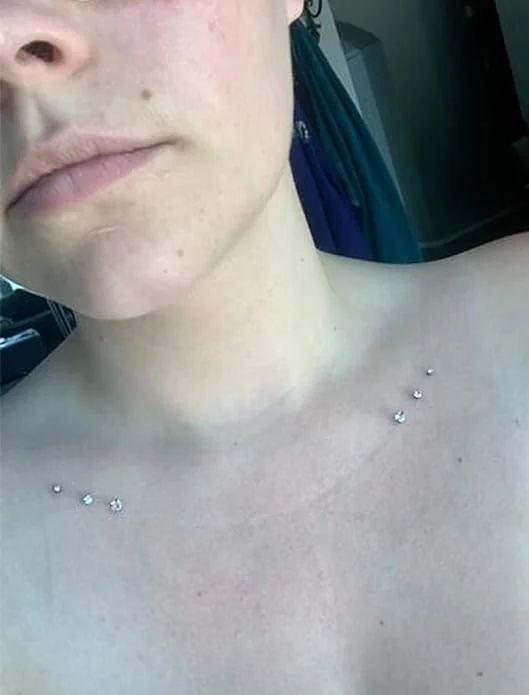
A dermal piercing stands out as a special type of body art. While traditional piercings go in one side and out the other, in a dermal piercing, a piercer anchors jewelry just under the skin. This makes it look like the jewelry simply “sits” on the skin, showing only the decorative top.
To put this in, a piercer uses a needle or a dermal punch to place the anchor, and then screws the jewelry top onto it. You can have a dermal piercing almost anywhere on your body, which is why many people love it as a unique and flexible style choice.
Dermal piercings can be customized according to your preference which is one of the best things about them. You can attach an ornament or even have multiple dermal piercings done to form a pattern on your skin. Popular areas for dermal piercings include:
- The thighs
- Abdomen
- Lower back
- Chest
- The nape of the neck
- Cheekbones
- Fingers
Is Dermal Piercing the Same as a Surface Piercing?

Dermal and surface piercings offer unique ways to adorn the body, but they have key differences. In a dermal piercing, a piercer punctures the skin once and anchors jewelry just below the surface. This makes only the jewelry’s decorative top show, making it look like it’s “floating.”
In contrast, surface piercings go through a section of skin, entering at one point and exiting at another. This makes the jewelry, whether it’s a bar or ring, look like it’s lying flat on the skin.
Dermal piercings give you more options for where you can place them, but surface piercings might not last as long because the body can sometimes push the jewelry out. When deciding, think about what look you want and how you’ll care for the piercing.
Origin and History of Dermal Piercings
Dermal piercings have gained a lot of attention in today’s body modification scene, but as mentioned earlier, they’re a newer trend in the long history of piercings. While people have been getting piercings for thousands of years in many cultures, the techniques and tools for dermal piercings only started popping up in the late 20th and early 21st centuries.
These piercings let you insert jewelry just below the skin, a twist that came from new techniques and jewelry designs. People wanted fresh ways to show off their piercings, and the “floating” look of dermal jewelry caught their eyes. The creation of the dermal anchor, essential for this type of piercing, really pushed its popularity.
While many piercings have deep cultural or ritual meanings, dermal piercings seem to come more from a modern love of style and new piercing tech. And because you can place them almost anywhere on the body, their appeal has grown even more in recent years.
How are Dermal Piercings Done?
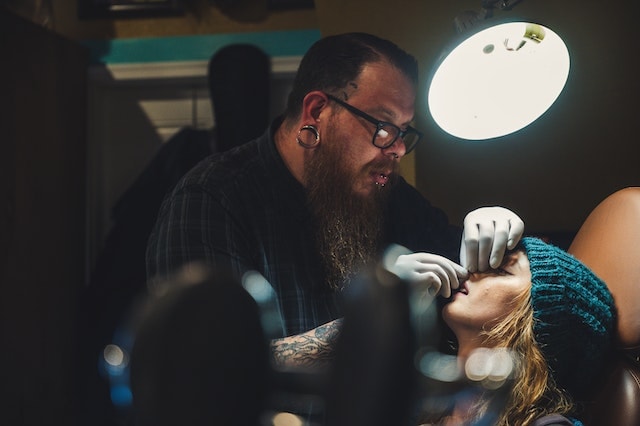
When you go in for your piercing, your piercer will first examine the area to make sure there won’t be any issues and that it’s fit to be pierced.
Then, they will sterilize the site using a surgical scrub and mark the spot with a surgical pen. Once it’s marked precisely, the piercer will use a needle or a dermal punch to make the pouch in your skin.
Unlike a needle that separates the skin, the dermal punch removes a bit of tissue but is less painful and much safer than using a needle.
Next, using a pair of forceps, the piercer will carefully insert the base of the anchor into the pocket or the hole created with the needle, pushing the anchor in all the way until it’s completely underneath the skin and positioned parallel to the surface.
Finally, they will screw the jewelry onto the screw head of the anchor and that’s it! You’re done and ready to go!
Choose an Experienced Piercer
This piercing is quite complicated so do your research before choosing a piercing studio. Unlike other ordinary piercings, this requires creating a pouch or a hole under your skin which can cause complications if it isn’t done by a skilled professional.
The dermal layer of your skin contains blood vessels and nerves which can be easily damaged if the piercing is not inserted properly. If the equipment used for your piercing is not sterilized, it can cause serious infections so make sure you find a reputed piercer before you go ahead with it.
What are the Best Metals for Dermal Piercing?
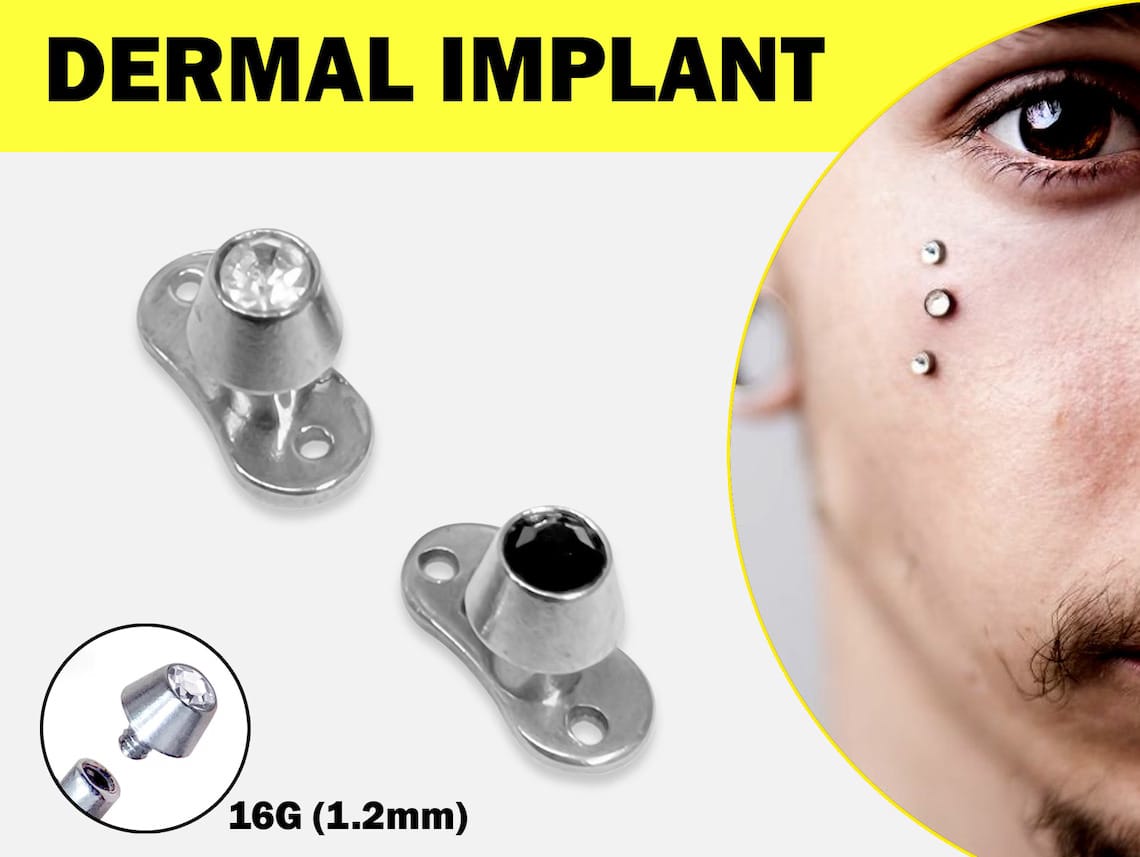
When choosing jewelry for your piercing, go for metals that are biocompatible and hypoallergenic.
Titanium or anodized titanium (any metal coated with titanium) is great for those with sensitive skin as they are least likely to cause any irritation.
You can also opt for surgical-grade stainless steel as this is one of the most popular metals used for body piercing jewelry. While it’s a safe metal, there is a chance of it causing irritation so if you’ve got sensitive skin and you buy low-quality stainless steel. Always look for surgical grade.
Niobium is another type of metal similar to titanium and is also hypoallergenic as well as non-corrosive. These metals may be a bit expensive but it’s always better to pay more for a high-quality product than to pay less and end up with an allergic reaction due to cheap metals.
What’s the Best Jewelry for Dermal Piercings?
Dermal piercings don’t give you a lot of jewelry options, but you can still find unique and creative jewelry styles to dress up your piercing. Here are some jewelry options you can choose from.
1. Dermal Anchor and Top
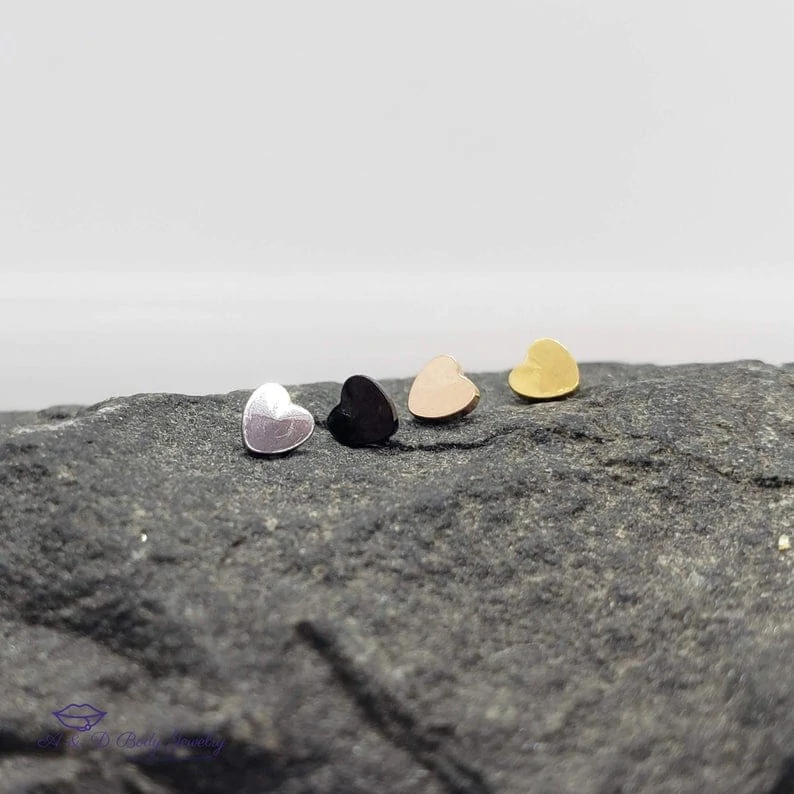
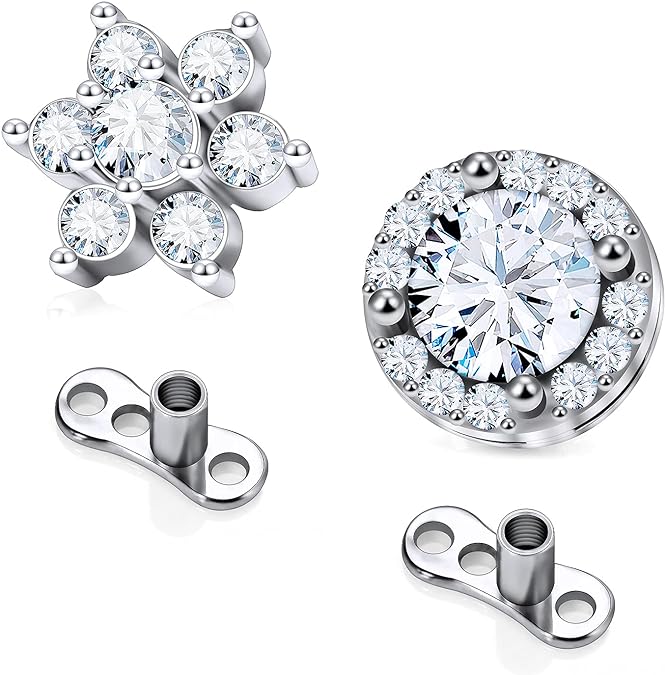
Dermal anchors are the jewelry of choice for traditional dermal piercings. Anchors have a flat base which is installed underneath the skin. The base or ‘foot’ has holes in it through which the flesh grows as the piercing heals.
Once it’s healed completely, the jewelry stays firmly in place and will not rip out easily. You can try all kinds of anchor tops such as metal studs or magnetic gems. There are endless designs and styles from simple titanium and steel discs to balls, cones, and animal-shaped tops so have fun choosing!
2. Skin Divers
Skin divers are small pieces of jewelry implanted partially underneath the skin. Unlike dermal anchors, the base of the skin diver that lies under the surface of the skin has a pointy end. In order to insert this jewelry, the piercer has to use a dermal punch to create a hole inside which the jewelry can sit.
Also, unlike dermal anchors, the exposed end of the jewelry (the top) is fixed permanently and cannot be changed so choose carefully because you will be stuck with the jewelry you pick.
Dermal Piercing Pain and Aftercare

Dermal piercing pain depends on the type of piercing, the location, and the method of piercing used. For example, a dermal punch is far less painful than using a needle.
However, in general, they can be more painful than most other piercings even during the healing process. The level of pain you feel depends on your pain threshold so although it may hurt badly for some people, for others it may hardly hurt at all.
This piercing can take up to three months to heal, but it can take longer or less time depending on the location of the piercing. During this time, it is important that you follow the rules of aftercare as best you can since this can help speed up the healing process while at the same time minimizing the risk of infections and other complications. Here are some tips on how to take good care of your piercing so it will heal faster.
- Cover up the piercing with a band-aid for a few days to keep it safe and clean and avoid putting pressure on it. Until it heals completely, it can easily become dislodged, so you need to pay extra attention to it during the healing phase.
- Avoid pulling, pushing, or pinching the skin as much as you can. The tissue around the piercing site can easily get irritated so take extra care when getting dressed, using a towel, and even when deciding what to wear. Clothes that have tiny holes in them are a big NO as the holes can get caught on the piercing. Whenever you need to touch your piercing, wash your hands thoroughly first or put on a pair of gloves.
- Clean your piercing using a salt solution or saline at least twice a day and dry it carefully with a paper towel. Don’t use pieces of cloth or even your own towel to wipe it dry as these can harbor bacteria that may cause infection. It’s very easy for germs to find their way into this piercing and it can be tough to clean it, making it highly prone to infections.
- Avoid swimming until your piercing has healed. You never know what’s swimming in there with you and the last thing you need is to prolong the healing process by getting an infection, making things even more unpleasant and complicated.
- If crust forms over or around the piercing, resist the urge to pick at it or remove it by force. Crusting is a perfectly normal part of the body’s healing process so just chill and let your body take care of the healing.
- If you change your mind and decide to remove the piercing, DO NOT do it yourself. You could end up damaging blood vessels or even nerves depending on the location of the piercing. Go to a professional piercer and have it removed carefully. Removing the piercing can be a painful process and may even result in scarring so think carefully before you go ahead and get the piercing done at all.
During the healing period, keep a close eye on your piercing for signs of infection such as redness, swelling, pain, irritation, and tenderness. Sometimes, pus can start to ooze from an infected piercing.
Fever is a major sign to watch out for so if you experience it and/or any of the signs we’ve mentioned, make sure you seek medical help immediately. Whatever you do, don’t ignore it and expect to cure it at home as this could make the situation even worse.
How Much Does a Dermal Piercing Cost?
Dermal piercings can be a bit expensive, costing anywhere from $70 to $100, depending on the location of the piercing and the method used. Some piercing studios charge separately for the jewelry so this could be an added $10 or $20 to the overall cost.
When considering the cost of getting this piercing done, don’t forget that you will also have upfront costs related to the aftercare of the piercing like saline solution or sea salt soaks.
Pros and Cons of Dermal Piercing

Have all the information you need but still having trouble deciding on this piercing? Weighing the pros and cons might make it a little easier for you to make up your mind.
Dermal Piercing Pros
- Suitable for many body areas.
- Offers a distinct “floating” jewelry appearance.
- Requires just one puncture point.
- Professional removal leads to lesser scarring.
- Various jewelry tops available for personal touch.
- Looks unique
Dermal Piercing Cons
- Can be difficult to clean
- Snags easily on clothing
- It’s highly prone to rejection, migration, and scarring
- It’s more painful than most other piercings
- It may not be accepted in some settings
- Takes months to heal fully.
Before You Commit
If you’re considering getting a dermal piercing done, you might want to put some thought into it first as it requires a great deal of commitment and care.
Keep in mind that if your body rejects it or if you want to get it removed later on, you could end up with a permanent scar which could be very difficult and expensive to remove so if you don’t want to take the risk of getting scarred, you might have second thoughts about this piercing. On the other hand, if you’re up for it and looking to get that sexy and stylish look this piercing offers, this could be the perfect choice for you.
The dermal piercing is more complicated than it looks and if you do decide to go ahead with it make sure you have the time and the resources that you need to take excellent care of it. Commitment is key so if you’re sure that you’re ready for it, go ahead and enjoy your new piercing!
Wrapping Up
Dermal piercings bring a fresh and modern flair to body art. They stand out with their “floating” jewelry look and you can place them almost anywhere on your body. They offer benefits like easy customization, but you should also consider challenges like longer healing times and the risk of snagging. Always do your homework and talk to a professional piercer to make sure you get the best and safest dermal piercing experience.









